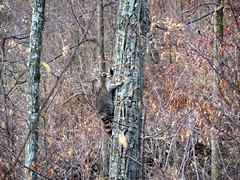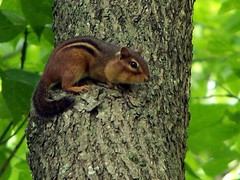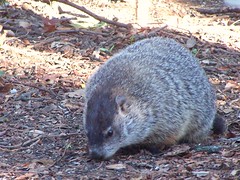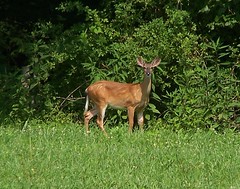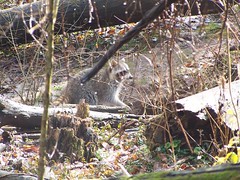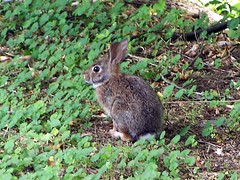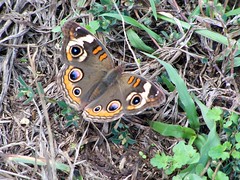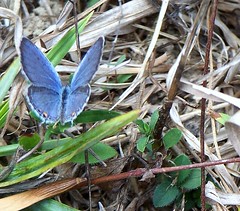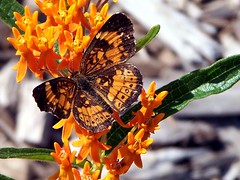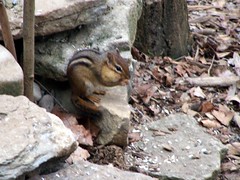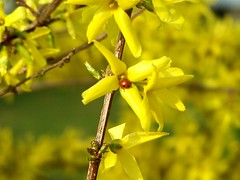I more often have seen their little hand-shaped tracks in the mud down by the pond or creek than I have actually spotted these bandits at the farm, but they are there. They're probably easiest to spot early in the morning or at night.
The one in this photo was scrambling up a tree off the ridge path as I took an early morning hike.
Thursday, November 27, 2008
Friday, October 17, 2008
Chipmunk
While I haven't personally spotted any chipmunk yet at the farm, they're almost certainly there scampering about the woods, singing songs and hoping that Disney will make a movie out of them.
Groundhog
Also known as the woodchuck and, my favorite, the whistlepig. I don't believe one has been spotted at the farm, but they're in the region.
Monday, September 22, 2008
Grasshopper
Just grasshopper. I don't think I'll try figuring out what sort of grasshopper this one is. As far as I'm concerned, it's just a grasshopper.
White Tailed Deer
My heart's in the Highlands, my heart is not here;
My heart's in the Highlands a-chasing the deer.
~Robert Burns
My heart's in the Highlands a-chasing the deer.
~Robert Burns
Racoon
Some people call me the space cowboy, yeah
Some call me the gangster of love
Some people call me maurice
Cause I speak of the pompitous of love
~Steve Miller
Some call me the gangster of love
Some people call me maurice
Cause I speak of the pompitous of love
~Steve Miller
Cottontail Rabbit
ONCE upon a time there
were four little Rabbits,
and their names were--
Flopsy,
Mopsy,
Cotton-tail,
and Peter.
They lived with their Mother
in a sand-bank, underneath the
root of a very big fir tree.
~Beatrix Potter
were four little Rabbits,
and their names were--
Flopsy,
Mopsy,
Cotton-tail,
and Peter.
They lived with their Mother
in a sand-bank, underneath the
root of a very big fir tree.
~Beatrix Potter
Common Buckeye Butterfly
As this brownish butterfly flooples* by, it may appear rather drab and colorless. BUT, if it alights somewhere and opens its wings, you can see how truly bright and showy it looks.
[* flooples: v. the flight of a butterfly. copyright 2008, Dan Trabue]
[* flooples: v. the flight of a butterfly. copyright 2008, Dan Trabue]
Eastern Tailed-Blue Butterfly
My best guess is that this is an Eastern Tailed-Blue Butterfly, which are found in this region and seems to match the description.
This is a softly shimmering blue little butterfly that I've seen flying in the farm field.
This is a softly shimmering blue little butterfly that I've seen flying in the farm field.
Wednesday, September 10, 2008
Thursday, July 17, 2008
Widow Skimmer Dragonfly
I don't know the name of this specific dragonfly, but I suspect it's Bob. He looks like a Bob to me. Looking at some guides, I believe Bob more properly goes by the name of Widow Skimmer.
There are always plenty of dragonflies and damselflies to be found around the pond, along the streams and in the field at the farm during the warm months. And, given the right light at the right angle, their colors are just brilliant.
There are always plenty of dragonflies and damselflies to be found around the pond, along the streams and in the field at the farm during the warm months. And, given the right light at the right angle, their colors are just brilliant.
Monarch Butterfly
Resting atop the Butterfly flower, blooming brightly in the warm days at the end of June.
How do these guys ever make it to Mexico?
"Four to five generations separate the monarch populations that make the migration, so the butterflies that make the trek to Mexico are the great, great grandchildren of the previous generation to have made it."
Amazing.
How do these guys ever make it to Mexico?
"Four to five generations separate the monarch populations that make the migration, so the butterflies that make the trek to Mexico are the great, great grandchildren of the previous generation to have made it."
Amazing.
Friday, May 16, 2008
Chipmunk
While I haven't personally spotted any chipmunk yet at the farm, they're almost certainly there scampering about the woods, singing songs and hoping that Disney will make a movie out of them.
Tuesday, May 13, 2008
Groundhog
Also known as the woodchuck and, my favorite, the whistlepig. I don't believe one has been spotted at the farm, but they're in the region.
Wednesday, April 30, 2008
Eastern Box Turtle
Very common in this region, many Eastern Box Turtles - and many turtle shells - have been spotted around the farm. They tend to go into hibernation around November (in this part of the world) and digging their way out of hibernation in March or April.
Subscribe to:
Posts (Atom)
